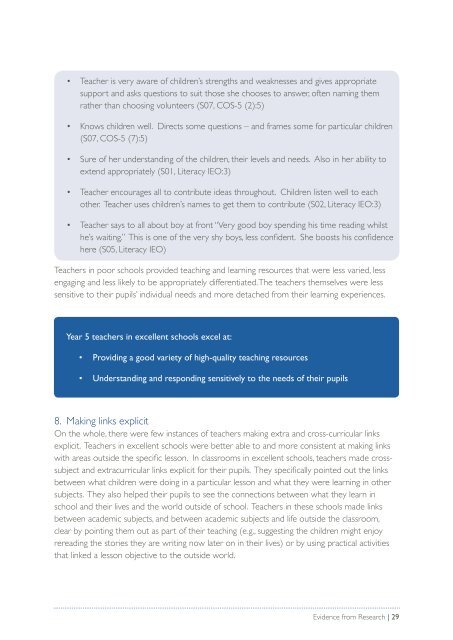Pearson-Exploring-Effective-Pedagogy-in-Primary-Schools
Pearson-Exploring-Effective-Pedagogy-in-Primary-Schools
Pearson-Exploring-Effective-Pedagogy-in-Primary-Schools
You also want an ePaper? Increase the reach of your titles
YUMPU automatically turns print PDFs into web optimized ePapers that Google loves.
• Teacher is very aware of children’s strengths and weaknesses and gives appropriatesupport and asks questions to suit those she chooses to answer, often nam<strong>in</strong>g themrather than choos<strong>in</strong>g volunteers (S07, COS-5 (2):5)• Knows children well. Directs some questions – and frames some for particular children(S07, COS-5 (7):5)• Sure of her understand<strong>in</strong>g of the children, their levels and needs. Also <strong>in</strong> her ability toextend appropriately (S01, Literacy IEO:3)• Teacher encourages all to contribute ideas throughout. Children listen well to eachother. Teacher uses children’s names to get them to contribute (S02, Literacy IEO:3)• Teacher says to all about boy at front “Very good boy spend<strong>in</strong>g his time read<strong>in</strong>g whilsthe’s wait<strong>in</strong>g.” This is one of the very shy boys, less confident. She boosts his confidencehere (S05, Literacy IEO)Teachers <strong>in</strong> poor schools provided teach<strong>in</strong>g and learn<strong>in</strong>g resources that were less varied, lessengag<strong>in</strong>g and less likely to be appropriately differentiated. The teachers themselves were lesssensitive to their pupils’ <strong>in</strong>dividual needs and more detached from their learn<strong>in</strong>g experiences.Year 5 teachers <strong>in</strong> excellent schools excel at:• Provid<strong>in</strong>g a good variety of high-quality teach<strong>in</strong>g resources• Understand<strong>in</strong>g and respond<strong>in</strong>g sensitively to the needs of their pupils8. Mak<strong>in</strong>g l<strong>in</strong>ks explicitOn the whole, there were few <strong>in</strong>stances of teachers mak<strong>in</strong>g extra and cross-curricular l<strong>in</strong>ksexplicit. Teachers <strong>in</strong> excellent schools were better able to and more consistent at mak<strong>in</strong>g l<strong>in</strong>kswith areas outside the specific lesson. In classrooms <strong>in</strong> excellent schools, teachers made crosssubjectand extracurricular l<strong>in</strong>ks explicit for their pupils. They specifically po<strong>in</strong>ted out the l<strong>in</strong>ksbetween what children were do<strong>in</strong>g <strong>in</strong> a particular lesson and what they were learn<strong>in</strong>g <strong>in</strong> othersubjects. They also helped their pupils to see the connections between what they learn <strong>in</strong>school and their lives and the world outside of school. Teachers <strong>in</strong> these schools made l<strong>in</strong>ksbetween academic subjects, and between academic subjects and life outside the classroom,clear by po<strong>in</strong>t<strong>in</strong>g them out as part of their teach<strong>in</strong>g (e.g., suggest<strong>in</strong>g the children might enjoyreread<strong>in</strong>g the stories they are writ<strong>in</strong>g now later on <strong>in</strong> their lives) or by us<strong>in</strong>g practical activitiesthat l<strong>in</strong>ked a lesson objective to the outside world.Evidence from Research | 29


